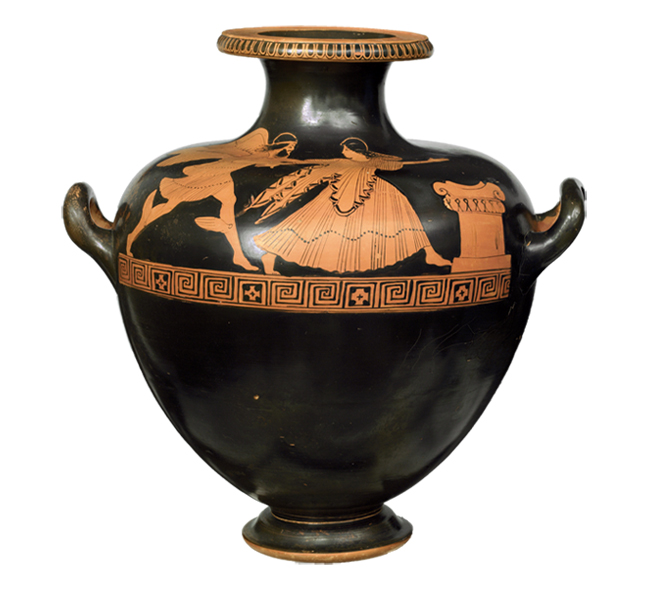Exhibit of the month
Enwrapped by the ferocious wind …
Attic red-figure hydria
National Archaeological Museum
Vase and Minor Arts Collection, inv. no A13119
Provenance: Liosia, Athens
Dimensions: H. 34.2 cm, Diam. of rim 13.8 cm, Diam. of base 11.5 cm
Date: circa 470 BC
Display location: Vase Collection, Room 55, Showcase 96
A bearded winged man is depicted on the shoulder of the hydria grabbing with both hands a young woman as she approaches an altar. The woman is startled by the violent movement of the man turning her head towards him with a frightful gaze, whereas she has already raised her other arm in a help-seeking gesture. The tension of the scene is reflected by the vase painter in the movement of the man’s himation and the impressive flowing garments of the maiden, but also her hair which has been pulled back and tied into a lampadion plait blowing backwards.
The scene that has been attributed to an artist conventionally named “Pan Painter” illustrates the myth of the abduction of the princess Oreithyia [1]by the personified north wind Boreas. Boreas, son of Astraeus and Eos or, according to a different version, son of Aeolus, found himself one day in the Attic sky where he encountered a group of maidens, but was captivated by the most beautiful and noble among them. She was Oreithyia, daughter of the king of Athens Erechtheus. Boreas appealed to the king asking him to marry his daughter, yet the sovereign employed stratagems so as to avoid this union that would take his child away from him. Boreas, enraged at the insult, abducted Oreithyia and transferred her to his far-flung homeland, Thrace[2], flying over the seas, where he forced himself on her.
The vase illustrates an Attic myth that reflects the life-giving and fertilizing power of the north winds which starting from Thrace reach Attica rejuvenating its basin. The dissemination of the myth was further supported by a historical event dating back to the Persian Wars that actually rescued the Athenians. For the sake of his wife, Boreas helped the Athenians by destroying the fleet of the Persians at Athos and Artemision. Following the devastation of the Persian fleet the Athenians honoured Boreas together with the god Poseidon by erecting an altar on the banks of Ilissos River where the abduction of Oreithyia had taken place.
However, the depiction of the altar in this representation denotes that the kidnap of the maiden did not occur on Ilissos River, where Oreithyia was playing with her companions, which is the most widespread version of the myth. According to Acusilaus of Argos, one of the first historians who lived in the late 6th – early 5th c. BC, the daughter of the mythical Erechtheus was captured on the Acropolis when she was offering sacrifices to Athena Polias as kanephoros[3] (a maiden leading a procession to sacrifice at festivals carrying a ritual basket, the kanoun) and it is possible that the iconography of this vase refers to this account.
[1] The name Oreithyia is first mentioned by Homer in Iliad (XIX 48) as a Nereid participating in the lament of her sister Thetis for the loss of her only son, Achilles.
[2] There are many locations that Oreithyia is said to have been transported after her capture: Strymon river, the Bistonian forest, the land of Kikons, the land of Odryssians, Skythia, Caucasus, the Ripaia Mountains, the Haemus, the river Ergenes, the Thracian Sarpedonia or the country of the god-fearing Hyperboreans.
[3] As part of the Panathenaic festival in Athens in honor of goddess Athena, on the 28th of the month Ekatomvaion, a large procession began carrying offerings for the goddess, together with her sacred veil, intended for her cult statue. The priestesses with the sacred utensils leading the procession followed by virgins, descendants of great families, as kaneforoi, those who carried on the heads baskets, full of offerings for the goddess. A representation of them is preserved on the freeze of the Parthenon. According to tradition, this festival was established by the mythical king Erechtheus therfore, his daughter, Oreithyia was one of the firts kanephorous.
Dr Efi Oikonomou
Bibliography:
Herodotus, Histories, Ζ, 189 ff.
Die Fragmente der Griechischen Historiker, F Jacoby (ed.), Berlin 1923, 2 F 23.
Ν. Δ. Παπαχατζής, Παυσανίου Ελλάδος Περιήγησις, Αττικά vol. 1, 1974, 284-285, par. 19, 5.
LIMC III, Ι, BOREAS, cat. no 9, p. 135 and ΙΙ, p. 109.
Ι. Θ. Κακριδής, (ed.), Ελληνική Μυθολογία, Οι ήρωες, vol. 3, Αθήνα 1986, p. 33.


